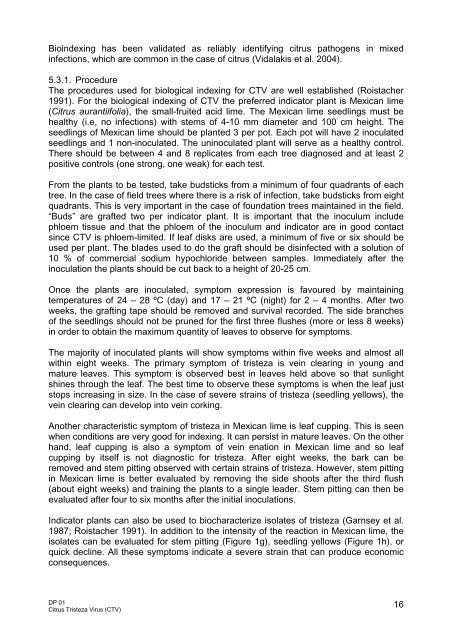NAPPO DIAGNOSTIC PROTOCOLS DP 01 Citrus Tristeza Virus (CTV)
NAPPO DIAGNOSTIC PROTOCOLS DP 01 Citrus Tristeza Virus (CTV)
NAPPO DIAGNOSTIC PROTOCOLS DP 01 Citrus Tristeza Virus (CTV)
- No tags were found...
You also want an ePaper? Increase the reach of your titles
YUMPU automatically turns print PDFs into web optimized ePapers that Google loves.
Bioindexing has been validated as reliably identifying citrus pathogens in mixedinfections, which are common in the case of citrus (Vidalakis et al. 2004).5.3.1. ProcedureThe procedures used for biological indexing for <strong>CTV</strong> are well established (Roistacher1991). For the biological indexing of <strong>CTV</strong> the preferred indicator plant is Mexican lime(<strong>Citrus</strong> aurantiifolia), the small-fruited acid lime. The Mexican lime seedlings must behealthy (i.e, no infections) with stems of 4-10 mm diameter and 100 cm height. Theseedlings of Mexican lime should be planted 3 per pot. Each pot will have 2 inoculatedseedlings and 1 non-inoculated. The uninoculated plant will serve as a healthy control.There should be between 4 and 8 replicates from each tree diagnosed and at least 2positive controls (one strong, one weak) for each test.From the plants to be tested, take budsticks from a minimum of four quadrants of eachtree. In the case of field trees where there is a risk of infection, take budsticks from eightquadrants. This is very important in the case of foundation trees maintained in the field.“Buds” are grafted two per indicator plant. It is important that the inoculum includephloem tissue and that the phloem of the inoculum and indicator are in good contactsince <strong>CTV</strong> is phloem-limited. If leaf disks are used, a minimum of five or six should beused per plant. The blades used to do the graft should be disinfected with a solution of10 % of commercial sodium hypochloride between samples. Immediately after theinoculation the plants should be cut back to a height of 20-25 cm.Once the plants are inoculated, symptom expression is favoured by maintainingtemperatures of 24 – 28 ºC (day) and 17 – 21 ºC (night) for 2 – 4 months. After twoweeks, the grafting tape should be removed and survival recorded. The side branchesof the seedlings should not be pruned for the first three flushes (more or less 8 weeks)in order to obtain the maximum quantity of leaves to observe for symptoms.The majority of inoculated plants will show symptoms within five weeks and almost allwithin eight weeks. The primary symptom of tristeza is vein clearing in young andmature leaves. This symptom is observed best in leaves held above so that sunlightshines through the leaf. The best time to observe these symptoms is when the leaf juststops increasing in size. In the case of severe strains of tristeza (seedling yellows), thevein clearing can develop into vein corking.Another characteristic symptom of tristeza in Mexican lime is leaf cupping. This is seenwhen conditions are very good for indexing. It can persist in mature leaves. On the otherhand, leaf cupping is also a symptom of vein enation in Mexican lime and so leafcupping by itself is not diagnostic for tristeza. After eight weeks, the bark can beremoved and stem pitting observed with certain strains of tristeza. However, stem pittingin Mexican lime is better evaluated by removing the side shoots after the third flush(about eight weeks) and training the plants to a single leader. Stem pitting can then beevaluated after four to six months after the initial inoculations.Indicator plants can also be used to biocharacterize isolates of tristeza (Garnsey et al.1987; Roistacher 1991). In addition to the intensity of the reaction in Mexican lime, theisolates can be evaluated for stem pitting (Figure 1g), seedling yellows (Figure 1h), orquick decline. All these symptoms indicate a severe strain that can produce economicconsequences.<strong>DP</strong> <strong>01</strong><strong>Citrus</strong> <strong>Tristeza</strong> <strong>Virus</strong> (<strong>CTV</strong>)16













